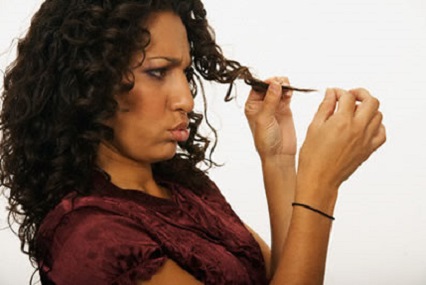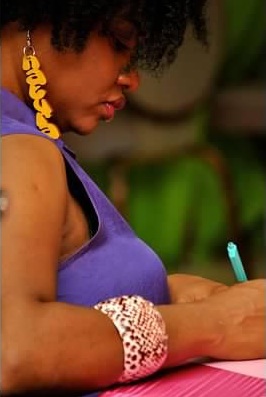 Throughout my
natural hair journey I have made a few mistakes from which I have had to pay
the price and, subsequently, learn lessons. There is a popular old wives
proverb that says "Experience teaches wisdom” and I can truly attest to that as
I have learned a thing or two as a result of my experiences. One such lesson has
to do with a natural hair horror that is seldom talked about. Single Strand
Knots.
Throughout my
natural hair journey I have made a few mistakes from which I have had to pay
the price and, subsequently, learn lessons. There is a popular old wives
proverb that says "Experience teaches wisdom” and I can truly attest to that as
I have learned a thing or two as a result of my experiences. One such lesson has
to do with a natural hair horror that is seldom talked about. Single Strand
Knots.
Single strand
knots can occur with natural hair, especially in hair types that have a more
kinky and coily appearance. With this hair type, there is generally a lot of
noticeable shrinkage and the hair is typically very wiry in texture. Single
strand knots are by definition, knots that are formed on a single strand of
hair. These tiny balls can be formed on one section or multiple sections of the
hair. The knots are formed when the hair coils around itself to the extent that
it actually makes a loop which eventually tightens and makes a knot.
It is somewhat puzzling and mind boggling even to fathom the possibility of that happening to a significant portion of your hair, but it certainly exists. In fact, single strand knots are also referred to as Fairy Knots because they are so tiny that it is jokingly said that only a fairy could have tied them.
THE CLUE

You might be
asking yourself "how do I even know if I am a victim of single strand
knots?” It is easy to miss the fact or
just pass it off as an unexplainable case of rough hair syndrome. The easiest
way of identifying single strand knots is to feel each individual strand of
hair, placing it between your thumb and index finger close to the root and
running your fingers downwards along the strand. Single strand knot is present
if a bump, knot or tie is felt at any point along the length of hair. Knots are
usually formed near the end of the strand thus making them easily identifiable
when examined on this basis.
You may also examine a whole section of hair by sliding all your fingers along the section. You will notice an unusual roughness or coarseness towards the end of your strands. Whilst this method is somewhat effective in identifying single strand knots, it may be difficult as your hair can feel similar changes in textures due to other reasons such as protein damage. To be certain, therefore, the best approach is to examine your hair strands individually.
THE CAUSE
 There are a
number of factors that can contribute to single strand knots.
There are a
number of factors that can contribute to single strand knots.
1. Failure to Detangle - Regular detangling can spare you a lot of drama throughout your natural hair journey. There is a common mistake of detangling hair only when it is being washed. The truth is however, that natural hair should always be kept free from tangles and knots. Keeping your hair in a matted and tangled state creates an ideal environment for the creation of single strand knots. Properly detangled hair is less likely to coil up around itself and form knots.
2. Failure to do Bedtime Protective Styling – Now we all know that it sometimes gets hard for a sister to fit everything into her daily schedule and still find time to attend to her hair at nights. With that being said, it is very understandable that we won’t always feel like sparing the extra minutes before bed to set our hair in a protective style. On one off occasion, that is totally fine but if this is a habit forming practice then we just might be setting ourselves up for a single strand knot disaster. Sleeping without your hair in a protective style can cause your ends to get tangled, matted and knotted which can cause strands to form loops resulting in single strand knots.
3. Failure to Moisturize - Allowing your hair to become too dry and brittle can also lead to single strand knots. Hair that lacks moisture will have a tendency to become untamed and easily coiled up. Lack of moisture is the culprit for many a natural hair woes.
4. Frequent Wash and Go’s – Wearing wash and go’s frequently will expose your hair to a greater risk of experiencing single strand knots. Wash and go hairstyles are worn on freshly washed hair that is allowed to air dry without styling. This usually causes extensive shrinkage and ultimately increases the chances of your tightly coiled hair forming knots.
THE CURE
 Having discovered that you are a
victim of single strand knots, the challenge is now to determine how to reverse
it. Let me just cut to the chase by saying there really is no cure for these
pesky annoyances. Once these knots find a permanent home on your locks, there
is no getting rid of them without, of course, cutting them off. This can be
quite devastating and can be a major setback depending on the position of these
knots. If the knots are formed towards the ends of your hair it may not be too
bad and can simply be trimmed off. If they are formed further up the hair shaft
however, then in order to get rid of them a significant portion of your hair
will need to be cut.
Having discovered that you are a
victim of single strand knots, the challenge is now to determine how to reverse
it. Let me just cut to the chase by saying there really is no cure for these
pesky annoyances. Once these knots find a permanent home on your locks, there
is no getting rid of them without, of course, cutting them off. This can be
quite devastating and can be a major setback depending on the position of these
knots. If the knots are formed towards the ends of your hair it may not be too
bad and can simply be trimmed off. If they are formed further up the hair shaft
however, then in order to get rid of them a significant portion of your hair
will need to be cut.
Having established that there is no cure, we are left with no choice but to adopt the "prevention is better than cure” mentality. There are a few steps that can be taken to prevent being plagued by these knots. Keeping your hair in a detangled and moisturized state is key to avoiding such occurrence. It is also highly advisable to keep your ends protected and sealed as often as possible to prevent your hair from even getting the opportunity to form these knots. If your hair is twisted, plaited, braided or tucked, then it is less likely to experience single stand knots. Minimize the frequency with which you wear wash and go’s and try to keep your ends stretched to prevent them from easily forming knots. Rollers can be used to stretch your hair to prepare for styling.

Candie's Natural Hairnamix was birthed a few months after Jamaican native Rossette "Candie" Allen began her natural hair journey in May 2010. She gears this column toward naturals, transitioning naturals, aspiring naturals and the naturally curious, sharing experiences, expertise and experiments while celebrating emancipation from chemical slavery.
Exercise diligence in caring for and styling your hair and it will significantly reduce your chances of suffering from this and other natural hair nuisances.


